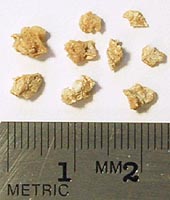Kidney Stones: Facts and Figures

These are some of the larger passed
fragments of a 1-cm kidney stone
that was blasted using lithotripsy.
|
Kidney stones are a common complaint in countries where the modern diet of processed foods persists, and in the USA the American Foundation for Urologic Disease estimates that 10 million people are diagnosed each year.
Many of them will suffer repeatedly, unless they change their dietary and lifestyle habits.
Kidney stones most commonly affect Caucasian men between the ages of 30 and 50 and those who have a family history of the condition. They are rare in children.
Many African tribes never experience them, probably because their diets are low in animal protein and high in fiber.
They are sometimes more prevalent in hot areas, the likely cause being increased level of dehydration.
Kidney stones range in size from microscopic specks to the size of a fingertip.
There are four types: uric acid stones, stones consisting of calcium oxalate, stones consisting of magnesium ammonium phosphate, and cystine stones. Eighty percent of all stones consist of calcium oxalate.
|